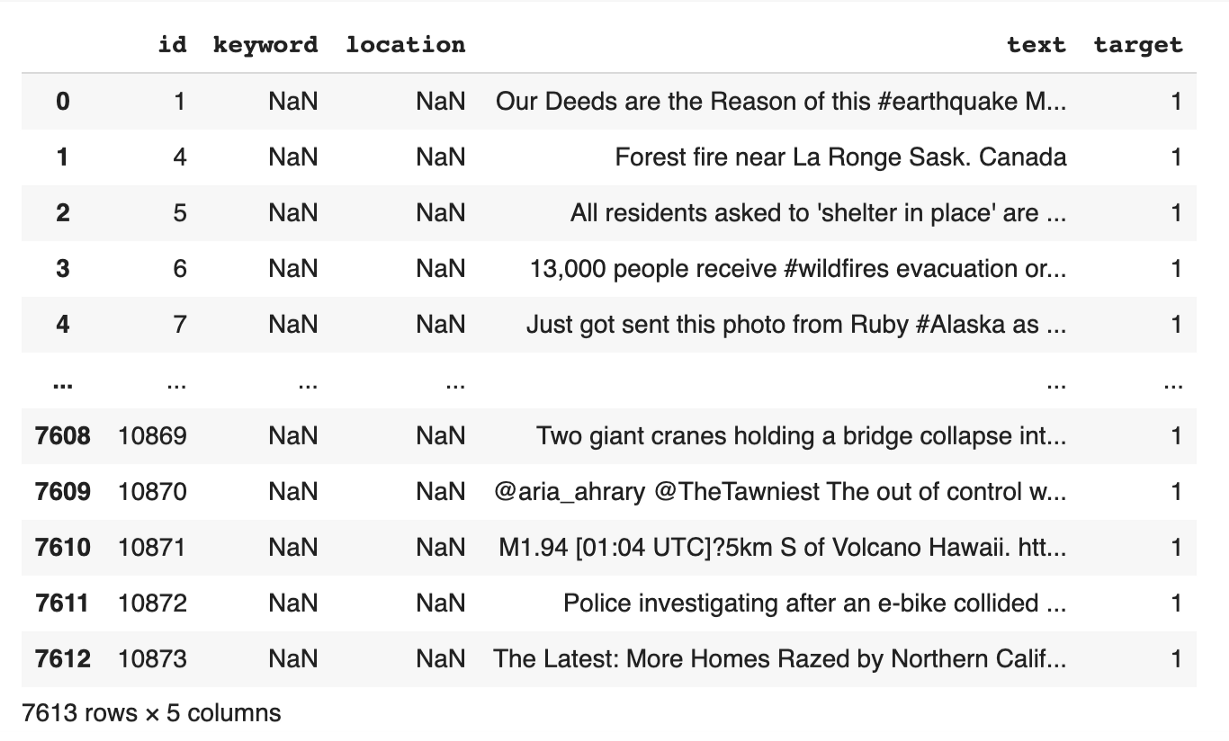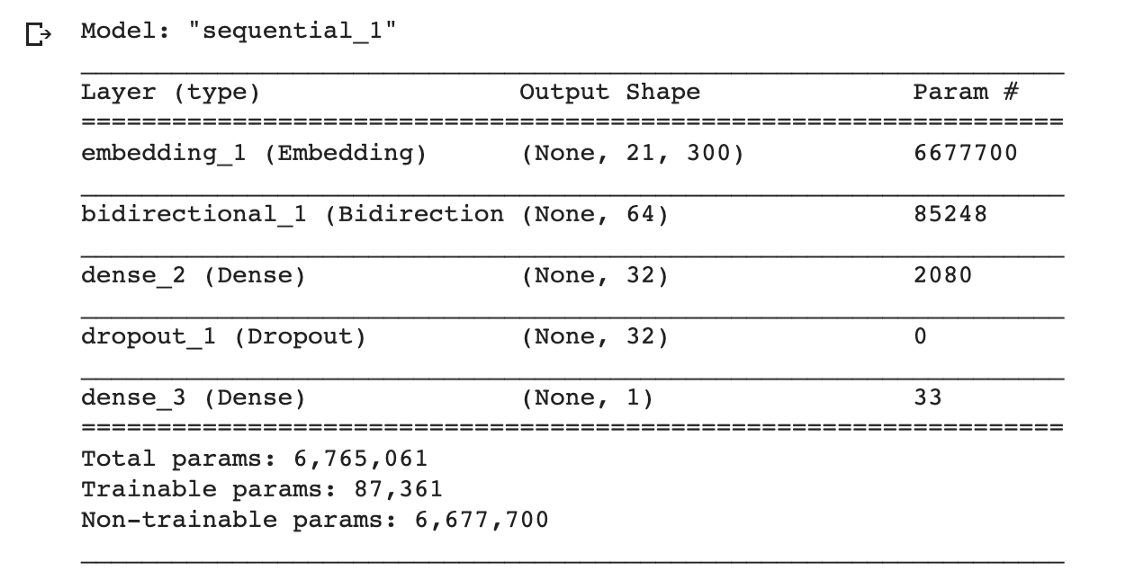您好,登錄后才能下訂單哦!
您好,登錄后才能下訂單哦!
這篇文章主要講解了“fastText和GloVe怎么使用”,文中的講解內容簡單清晰,易于學習與理解,下面請大家跟著小編的思路慢慢深入,一起來研究和學習“fastText和GloVe怎么使用”吧!
數據包括7613條tweet(Text列)和label(Target列),不管他們是否在談論真正的災難。有3271行通知實際災難,有4342行通知非實際災難。

文本中真實災難詞的例子:
“ Forest fire near La Ronge Sask. Canada “
使用災難詞而不是關于災難的例子:
“These boxes are ready to explode! Exploding Kittens finally arrived! gameofkittens #explodingkittens”
數據將被分成訓練(6090行)和測試(1523行)集,然后進行預處理。我們將只使用文本列和目標列。
from sklearn.model_selection import train_test_split
data = pd.read_csv('train.csv', sep=',', header=0)
train_df, test_df = train_test_split(data, test_size=0.2, random_state=42, shuffle=True)此處使用的預處理步驟:
小寫
清除停用詞
標記化
from sklearn.utils import shuffle
raw_docs_train = train_df['text'].tolist()
raw_docs_test = test_df['text'].tolist()
num_classes = len(label_names)
processed_docs_train = []
for doc in tqdm(raw_docs_train):
tokens = word_tokenize(doc)
filtered = [word for word in tokens if word not in stop_words]
processed_docs_train.append(" ".join(filtered))
processed_docs_test = []
for doc in tqdm(raw_docs_test):
tokens = word_tokenize(doc)
filtered = [word for word in tokens if word not in stop_words]
processed_docs_test.append(" ".join(filtered))
tokenizer = Tokenizer(num_words=MAX_NB_WORDS, lower=True, char_level=False)
tokenizer.fit_on_texts(processed_docs_train + processed_docs_test)
word_seq_train = tokenizer.texts_to_sequences(processed_docs_train)
word_seq_test = tokenizer.texts_to_sequences(processed_docs_test)
word_index = tokenizer.word_index
word_seq_train = sequence.pad_sequences(word_seq_train, maxlen=max_seq_len)
word_seq_test = sequence.pad_sequences(word_seq_test, maxlen=max_seq_len)使用fastText和Glove的第一步是下載每個預訓練過的模型。我使用google colab來防止我的筆記本電腦使用大內存,所以我用request library下載了它,然后直接在notebook上解壓。
我使用了兩個詞嵌入中最大的預訓練模型。fastText模型給出了200萬個詞向量,而GloVe給出了220萬個單詞向量。
import requests, zipfile, io zip_file_url = “https://dl.fbaipublicfiles.com/fasttext/vectors-english/wiki-news-300d-1M.vec.zip" r = requests.get(zip_file_url) z = zipfile.ZipFile(io.BytesIO(r.content)) z.extractall()
import requests, zipfile, io zip_file_url = “http://nlp.stanford.edu/data/glove.840B.300d.zip" r = requests.get(zip_file_url) z = zipfile.ZipFile(io.BytesIO(r.content)) z.extractall()
FastText提供了加載詞向量的格式,需要使用它來加載這兩個模型。
embeddings_index = {}
f = codecs.open(‘crawl-300d-2M.vec’, encoding=’utf-8')
# Glove
# f = codecs.open(‘glove.840B.300d.txt’, encoding=’utf-8')
for line in tqdm(f):
values = line.rstrip().rsplit(‘ ‘)
word = values[0]
coefs = np.asarray(values[1:], dtype=’float32')
embeddings_index[word] = coefs
f.close()采用嵌入矩陣來確定訓練數據中每個詞的權重。
但是有一種可能性是,有些詞不在向量中,比如打字錯誤、縮寫或用戶名。這些單詞將存儲在一個列表中,我們可以比較處理來自fastText和GloVe的詞的性能
words_not_found = []
nb_words = min(MAX_NB_WORDS, len(word_index)+1)
embedding_matrix = np.zeros((nb_words, embed_dim))
for word, i in word_index.items():
if i >= nb_words:
continue
embedding_vector = embeddings_index.get(word)
if (embedding_vector is not None) and len(embedding_vector) > 0:
embedding_matrix[i] = embedding_vector
else:
words_not_found.append(word)
print('number of null word embeddings: %d' % np.sum(np.sum(embedding_matrix, axis=1) == 0))fastText上的null word嵌入數為9175,GloVe 上的null word嵌入數為9186。
你可以對超參數或架構進行微調,但我將使用非常簡單的一個架構,它包含嵌入層、LSTM層、Dense層和Dropout層。
from keras.layers import BatchNormalization import tensorflow as tf model = tf.keras.Sequential() model.add(Embedding(nb_words, embed_dim, input_length=max_seq_len, weights=[embedding_matrix],trainable=False)) model.add(Bidirectional(LSTM(32, return_sequences= True))) model.add(Dense(32,activation=’relu’)) model.add(Dropout(0.3)) model.add(Dense(1,activation=’sigmoid’)) model.summary()

from keras.optimizers import RMSprop from keras.callbacks import ModelCheckpoint from tensorflow.keras.callbacks import EarlyStopping model.compile(loss='binary_crossentropy', optimizer='adam', metrics=['accuracy']) es_callback = EarlyStopping(monitor='val_loss', patience=3) history = model.fit(word_seq_train, y_train, batch_size=256, epochs=30, validation_split=0.3, callbacks=[es_callback], shuffle=False)
fastText的準確率為83%,而GloVe的準確率為81%。與沒有詞嵌入的模型(68%)的性能比較,可以看出詞嵌入對性能有顯著的影響。
fastText 嵌入的準確度

GloVe 嵌入的準確度

沒有詞嵌入的準確度

感謝各位的閱讀,以上就是“fastText和GloVe怎么使用”的內容了,經過本文的學習后,相信大家對fastText和GloVe怎么使用這一問題有了更深刻的體會,具體使用情況還需要大家實踐驗證。這里是億速云,小編將為大家推送更多相關知識點的文章,歡迎關注!
免責聲明:本站發布的內容(圖片、視頻和文字)以原創、轉載和分享為主,文章觀點不代表本網站立場,如果涉及侵權請聯系站長郵箱:is@yisu.com進行舉報,并提供相關證據,一經查實,將立刻刪除涉嫌侵權內容。